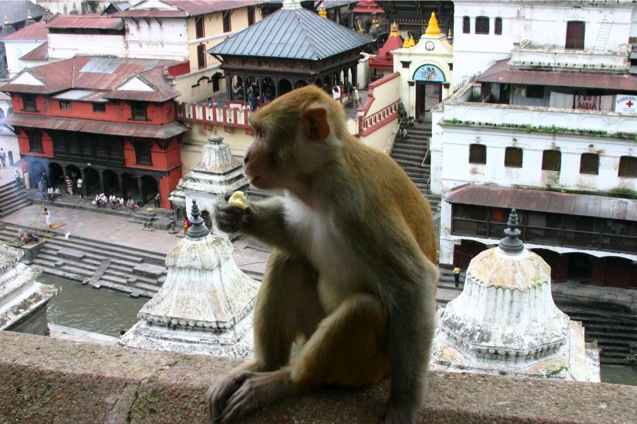
Kathmandu



Tuesday 5 September - Kathmandu
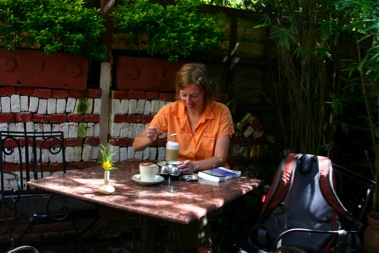 When we entered Kathmandu the day before, its maddening traffic didn’t seem to promise a place for recovery that we craved. First impressions turned out to be wrong, first of all because the hotel delivered (AC, hot shower, double bed). Second, once you get the hand of warding off all the beggars and salesmen, walking around Kathmandu is quite pleasant.
When we entered Kathmandu the day before, its maddening traffic didn’t seem to promise a place for recovery that we craved. First impressions turned out to be wrong, first of all because the hotel delivered (AC, hot shower, double bed). Second, once you get the hand of warding off all the beggars and salesmen, walking around Kathmandu is quite pleasant. Kathmandu, Eldorado of the Himalayas, home to…comprehensible English! Hot showers! Quasi-European “hot croissant and café latte” breakfast! English books! Deodorant! ORS! And everything else that makes battered travelers weep with joy, even though most of the brands are fake, and the soda has been imported here in the sixties.
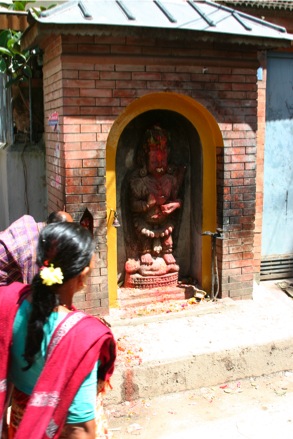 We shower, we indulge in foods we haven’t eaten for weeks, and shop for books at the “Barnes & Noble” (not related to the big chain) The city appears to be overflowing with luxury after the barren, basic stay in Tibet – it seems to be the perfect complement to Tibet. We spot travelers from all over the world (we primarily saw Dutch and Asians in Tibet), and everyone dresses casually, less modestly than in T. We feel out of place in our hardy (and by now quite worn) traveler’s gear.
We shower, we indulge in foods we haven’t eaten for weeks, and shop for books at the “Barnes & Noble” (not related to the big chain) The city appears to be overflowing with luxury after the barren, basic stay in Tibet – it seems to be the perfect complement to Tibet. We spot travelers from all over the world (we primarily saw Dutch and Asians in Tibet), and everyone dresses casually, less modestly than in T. We feel out of place in our hardy (and by now quite worn) traveler’s gear.Kathmandu caters to Westerlings’ New Age “sensitivity” by selling spiritual trinkets and cd’s en masse. The disappearance of the language barrier feel like an enormous relief. Being here is like letting out a deep breath. Things are easy again: People understand you without any glitches, if you want to, you can have wicked Penne all’Arrabiata at “La Dolce Vita,” showers work, there’s plenty of oxygen in the air…
In short: Despite its being loud and hectic, Kathmandu is a wonderfully welcoming place, where tourism is obviously an old tradition, where the Westerling can regroup and feel alien without the occasional frustrations that come with the language barrier in China and Tibet.
And yet…I miss Tibet!
This rhymes, so it’s true.
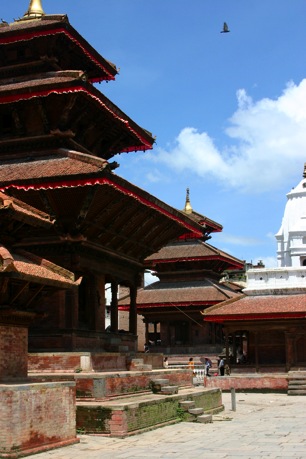 On our first day in Kathmandu, we breakfasted in a place called “Pumpernickel,” relishing the mild morning, the cappuccino, the European Bistro atmosphere, which was enhanced by the fact that each table was occupied by a party from a different country, among them two students from Heidelberg, Germany!
On our first day in Kathmandu, we breakfasted in a place called “Pumpernickel,” relishing the mild morning, the cappuccino, the European Bistro atmosphere, which was enhanced by the fact that each table was occupied by a party from a different country, among them two students from Heidelberg, Germany!After exploring Thamel (the tourist quarter) buying BOOKS!, having breakfast at the Pumpernickel (a place with great bread), we venture South towards Durbar Square, the center of Kathmandu with a high concentration of Pagoda-style temples that are so typical for Nepal. Of course sales/guide/beggar/holy man harassment is peaking here too. 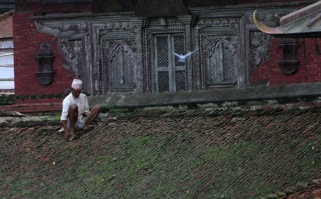

Here, the disadvantage of Kathamdu’s status as a seasoned tourist town became quite obvious – a flood of “offers,” all starting with the same trite opener, “Where are you from?” trailed us all the way.
I couldn’t refrain from a sharp reply or two, but Niels, who’s been to India, advised me that indifference works best.
Durbar Square was quite beautiful, and we rested on the steps of a big temple for a while, taking in the colorful bustle ripe with Westerlings – so different from Tibet!
We decide to visit the “monkey” temple next, which is in the West of the city, and to try and walk there. We walked to the Monkey Temple and got lost on the way – which provided us with an interesting experience of the “real” (i.e. non-Thamel) Kathmandu. We walked through small streets, eliciting amusement rather than business instinct – especially when we accidentally ended up in a dead end street.
Crossing through the city we find ourselves in narrow streets and neighborhoods where women do laundry and children play around, and no beggar tries to leech on.
It’s important to keep in mind that a large part of the Nepalese (and, in fact, a large part of most peoples) is disinterested in tourists. In Thamel, which is tailor-cut to the traveler’s needs and desires, it’s easy to forget this.
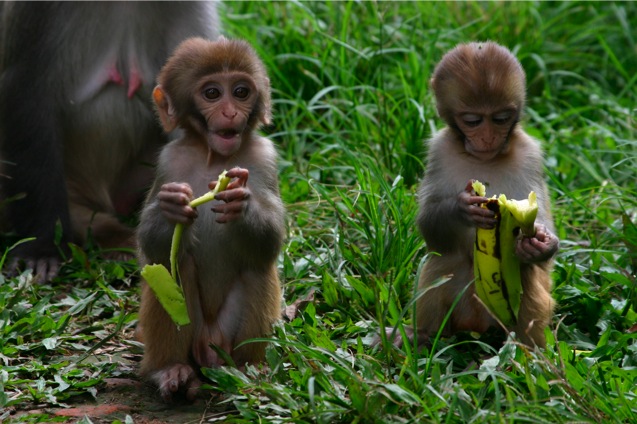
After a lot more walking we find ourselves at the entrance of the temple, which is at the bottom of a high hill–the temple itself is of course on top of it. A boy latches onto us serving as an uninvited guide, who tells us there are 365 steps between us and the top, and that we should take it slowly. 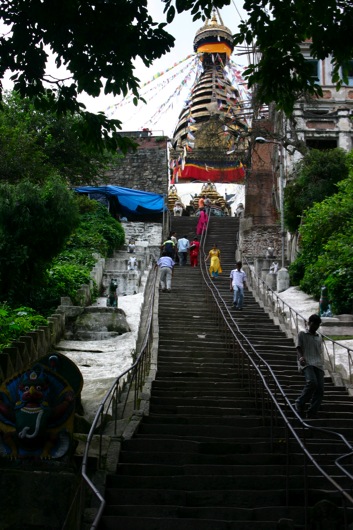 Our Himalaya-oxygenated blood should to the trick (but the heat knocks us off). There is enough entertainment on the stairs in the form of the monkeys that give the temple its nickname. Some people give monkeys bananas, and we marvel at how proficient they are at eating them.
Our Himalaya-oxygenated blood should to the trick (but the heat knocks us off). There is enough entertainment on the stairs in the form of the monkeys that give the temple its nickname. Some people give monkeys bananas, and we marvel at how proficient they are at eating them.
 Our Himalaya-oxygenated blood should to the trick (but the heat knocks us off). There is enough entertainment on the stairs in the form of the monkeys that give the temple its nickname. Some people give monkeys bananas, and we marvel at how proficient they are at eating them.
Our Himalaya-oxygenated blood should to the trick (but the heat knocks us off). There is enough entertainment on the stairs in the form of the monkeys that give the temple its nickname. Some people give monkeys bananas, and we marvel at how proficient they are at eating them.Finally on top we enjoy the view, although Kathmandu just seems like a grey sea of houses. The main temple is a stupa with eyes, a small version of the for tomorrow anticipated Bodhiva stupa.
Down again we buy the boy the agreed-upon milk, which turns out to be a Rp 450 (4.50 Euro) tin of dried milk. “For his sister”. Clever bastard.
The Monkey Temple is an interesting concoction mixing Buddhist stupas, Hindu shrines and many, many stairs, not to forget the nifty monkeys, into a slightly mad experience. Accompanied by our self-appointed guide, a boy of perhaps twelve who would do just fine in a round of debating monks, we climbed the stairs. Luckily, the high-altitude blood doping kept us from fainting or throwing up mid-way, but it was a close call – 365 stairs! 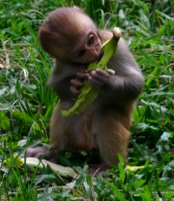 Constructed by an insane person!
Constructed by an insane person!
 Constructed by an insane person!
Constructed by an insane person!Somehow, Buddhism in Nepal is so different – it’s this odd religion in largely Hindu surroundings, with some huge stupas that stand out. In Tibet it’s simply omnipresent.
We enjoyed a view of sprawling Kathmandu and discovered that the Nepalese feed monkeys with bananas the same way we feed ducks with bread. It’s a pity you aren’t allowed to pet them. Their small faces look exactly like the faces of very old, toothless humans. And their long fingers and toes! Adorable!
Wednesday 6 September - Stupa & Funerals
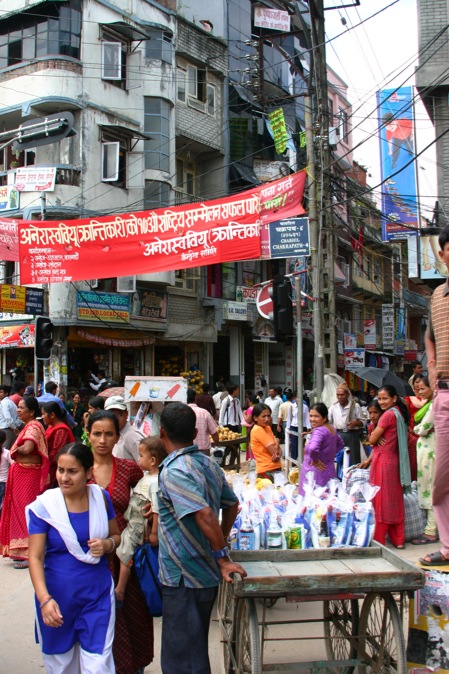 The strange familiarity of many things in Thamel (Western restaurants, e.g. the “Dolce Vita,” which feels Italian), the availability of familiar-brand items (Ritter Sport chocolate) – it’s all wonderful, but it also infuses me with a sense of home-sickness – for Tibet!
The strange familiarity of many things in Thamel (Western restaurants, e.g. the “Dolce Vita,” which feels Italian), the availability of familiar-brand items (Ritter Sport chocolate) – it’s all wonderful, but it also infuses me with a sense of home-sickness – for Tibet!The selling/ begging assaults become annoying, because the only way to deal with them is to say “no” to everything, which in turn makes you feel like an asshole, considering that most things here cost no more than a trifle.
Niels reminds me that we ARE leaving money in Nepal – we pay the hotel, the Immigration Service (for the visa), the bus driver, and we buy books and things in the Supermarket. Plus, many people DO buy souvenirs – just look at all the other tourists, many of whom wear locally sold jewelry, t-shirts or skirts and pants.
I miss the monasteries, the harsh landscape, even the simple food and beds. I will return to Tibet!
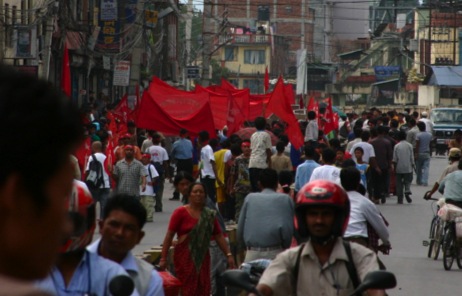
Today we want to visit the huge Bodhiva stupa in the East of the city. It is about 8 km, so we want to take a taxi. This proves to be almost impossible, because the Maoists have demonstrations today and block many major streets. We finally find a taxi that can bring us close to the Stupa at an inflated price (although Rp 400 is still not a lot of money). He drives us through a myriad of back alleys, and drops us off a few kilometers from the Stupa. Indeed, the upcoming streets are empty of motorized traffic (in Kathmandu!) and huge demonstration banners of the Maoists are everywhere. We walk on through and make it to the Stupa hoping that the Maoists don’t demand any taxation of us, which they don’t.
In the newspaper it said that taxi drivers were concerned about their safety during maoist activities, since some had been stabbed. They had officially gone on a strike.
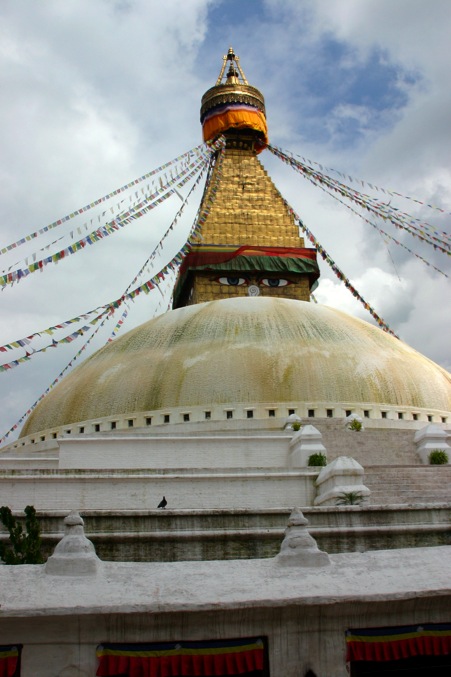
The Stupa is impressive–even though I saw it 15 years ago. It was spectacular with its large, skeptical eyes painted on top and the beautiful prayer flags attached to the “tip.” Memories of the Gyantse Kumbum! But the background of the stern fort and the naked mountains had now given way to exotic Kathmandu.
A monk from a local monastery leads us around. He is born in Lhasa, fled to Dharamsala, and is now stationed in Nepal, on which he didn’t seem to be too keen. But he was going to visit his family in Lhasa soon, after fifteen years. I asked him whether it was easy for him to get into Tibet, and he said it was. I don’t know whether that is because the paperwork is easy or because he sneaks in illegally. I suspect the latter.
We exchanged memories of Tibet, and he asked us whether we’d seen the monks debating in Sera, which was indeed one of the favorite memories of the trip. He seemed cheerful, but admitted missing Lhasa and finding Nepal too hot and crowded. His opinion of China was rather unambiguous: “China is no good.” He led us to a lama for a blessing and gave us white scarves. He even led us in a Buddhist prayer and asked us to light the monastery’s endearingly cheesy “100 lights stupa” (a small model with round light bulbs). It was all part of an elaborate blessing to solicit good luck on our flight back, and it made us feel good.
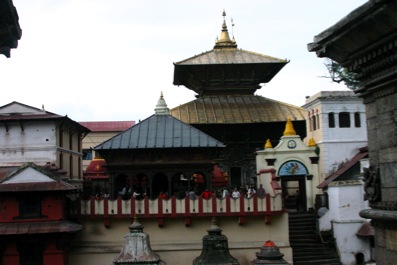 Interestingly enough, we later on ran into two Buddhist monks who glanced at the scarves, greeted us with the Tibetan “Tashi Delek” and asked us where we got them. When we told them they’d been a present they seemed to like that and invited us to join them for a meditation session at a cave (which we later saw across the river, close to the Pashupati temple, which is a big Hindu temple). We thanked them but declined, because we a) don’t know how to meditate (we didn’t admit this), and b) had only half a day left in Kathmandu and wanted to have a look at the Hindu temple.
Interestingly enough, we later on ran into two Buddhist monks who glanced at the scarves, greeted us with the Tibetan “Tashi Delek” and asked us where we got them. When we told them they’d been a present they seemed to like that and invited us to join them for a meditation session at a cave (which we later saw across the river, close to the Pashupati temple, which is a big Hindu temple). We thanked them but declined, because we a) don’t know how to meditate (we didn’t admit this), and b) had only half a day left in Kathmandu and wanted to have a look at the Hindu temple.The encounter left me wondering about the nature of the Buddhist subculture in Nepal – whether the Buddhists prefer to be among themselves, whether they dream of traveling to or returning to Tibet, or whether they feel at least a bit comfortable here after all. According to Hindus, Buddhism is compatible with Hinduism…
Our next target was the Pashupati temple, which was within walking distance (and walk we did because there was no taxi in sight anyway). The Pashupati temple is a Hindu temple, which is off-limits for non-Hindus. What you can see are the place along the river where they burn the dead. Two platforms left of the bridge (Royal family and high officials) and seven platforms to the right (Brahmans, Warriors, Merchants, Untouchables, and three extra because the caste system was officially abolished).
Men clad in white (the color of mourning) poked up the fires and eventually shoved the ashes into the river.
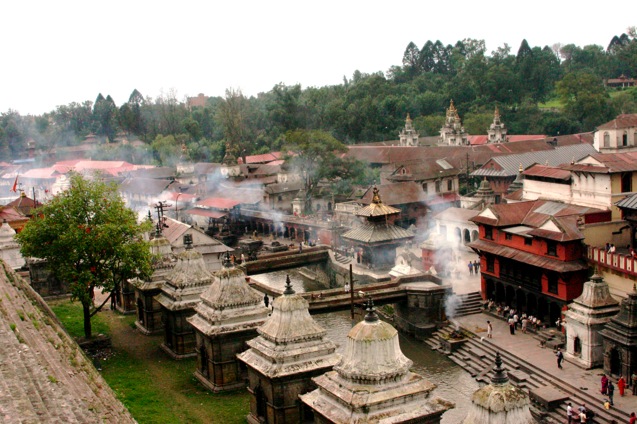 The cremations were very impressive. The dead body is placed on a platform, wrapped in white sheets and covered in straw and wood and incense. Fire is set to the body at the mouth, where the spirit is said to depart. Male members of the family or a priest do this duty. Women are often not allowed to stay during the burning of the body, but they “say goodbye” before that, wailing and crying loudly at the funeral site. Sometimes, an “undertaker” is present, a man dressed in white (the color of mourning), who stokes the fire and pushes resistant limbs back onto the burning pile to make sure everything burns to ashes. He also sweeps the ashes into the river at the end. The river in Kathmandu eventually flows into the holy Ganges, and according to Hindu custom ashes should be thrown into a holy river, or at least into a river that merges with a holy river.
The cremations were very impressive. The dead body is placed on a platform, wrapped in white sheets and covered in straw and wood and incense. Fire is set to the body at the mouth, where the spirit is said to depart. Male members of the family or a priest do this duty. Women are often not allowed to stay during the burning of the body, but they “say goodbye” before that, wailing and crying loudly at the funeral site. Sometimes, an “undertaker” is present, a man dressed in white (the color of mourning), who stokes the fire and pushes resistant limbs back onto the burning pile to make sure everything burns to ashes. He also sweeps the ashes into the river at the end. The river in Kathmandu eventually flows into the holy Ganges, and according to Hindu custom ashes should be thrown into a holy river, or at least into a river that merges with a holy river.A bridge divides the buried platforms for ordinary people from those for the Royal Family and important politicians. Interestingly, a hospice is situated right behind the burial platforms, and a home for the elderly is nearby. Sniff your fate!
Despite the ritual’s intensity, people seem to be quite at ease with it. Children bathe upriver, not far from the burial site, and people walk down the steps from the temple to the river to touch their feet and forehead in the water, right next to the burning bodies.
In fact, it’s possible to cross a bridge and walk up to a row of benches (which, in turn, are situated above a series of small fertility temples, where couples can offer milk, rice, and honey to the gods in order to conceive – we saw some remnants). The benches offer a “panoramic view” of the temple complex, including the riverbank and the burning bodies. The place seems to be a favorite hangout spot for Nepalese high school kids (there are many, many schools and universities in Kathmandu).
Monkeys were omnipresent here–one managed to steal Steffi’s banana, and insolently ate it right before our noses. A pull, the probing of nifty fingers between mine…a feisty monkey has stolen my banana and peels and eats it right in front of me, with obvious satisfaction! Unfortunately, he’s holy, so I can just nod and let it go.
